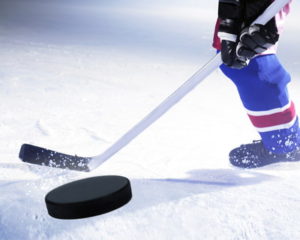 Ice hockey is known as one of Canada’s most famous exports, but there’s an argument it actually began life in the United Kingdom. It is known for its physicality as much as anything else, with players often smashing into each other as they compete over the puck and fights common. Whilst many associate the sport with North America, it’s actually equally as popular in the Nordic countries around Europe as well as in Russia.
Ice hockey is known as one of Canada’s most famous exports, but there’s an argument it actually began life in the United Kingdom. It is known for its physicality as much as anything else, with players often smashing into each other as they compete over the puck and fights common. Whilst many associate the sport with North America, it’s actually equally as popular in the Nordic countries around Europe as well as in Russia.
The game involves 2 teams with 6 players on each going head-to-head in an attempt to outscore each other. A physical sport that sees teams use sticks to move a rubberised puck around an ice skating rink, it is fiercely competitive. Matches last for 3 periods of 20 minutes each, though overtime will come into effect if there’s no winner at the end of the hour or so of the game. The National Hockey League, better known as the NHL, is the leading competition in the sport, but different countries have their own versions.
Best Betting Site For Ice Hockey
888

888 are not only massive they are also global and that means they have an appreciation for customers from the USA to Asia.
For a sport like Ice Hockey this is great as it means you can get the best of the US and Canadian markets as well as those from Europe and further east. The markets themselves are also deep with better than average value prices in the main.
Its not only their coverage which is good, they are one of the few betting sites to have offer for ice hockey, for both new and existing customers.
Betting On Ice Hockey
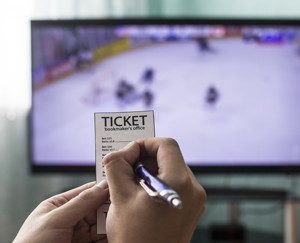 Because ice hockey is predominantly a North American sport, you’ll find that much of the language used around it has an American twist. Phrases such as ‘the money line’ are common, for example. Here’s a look at ice hockey betting’s most common markets:
Because ice hockey is predominantly a North American sport, you’ll find that much of the language used around it has an American twist. Phrases such as ‘the money line’ are common, for example. Here’s a look at ice hockey betting’s most common markets:
- The Money Line – This is the equivalent of of a To Win bet in sports you might by more used to betting on. You will often find that the odds are written in decimal form rather than fractional because that’s common in the US.
- The Puck Line – This is ice hockey’s equivalent to a handicap in another sport. The favourite will ‘give’ a certain number of goals to the other other team, meaning that they’ll need to outscore them by that number of bets in order for you to win your bet.
- Overs – How many goals will there be? Over 4.5 or Under 4.5? That’s what you’re betting on here. Do be aware that there is normally a market including overtime, so make sure you’re betting on that if you want the added time after a drawn game to be included.
The History Of Ice Hockey
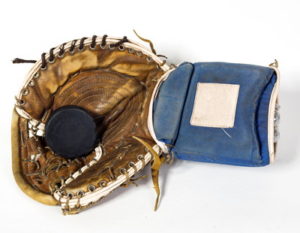 In 1773 Richard Johnson wrote a book with the rather convoluted name of “Juvenile Sports and Pastimes, to Which Are Prefixed, Memoirs of the Author: Including a New Mode of Infant Education”. The books 11th chapter was entitled ‘New Improvements on the Game of Hockey’, which is the first time that the sport of field hockey was referred to with that spelling.
In 1773 Richard Johnson wrote a book with the rather convoluted name of “Juvenile Sports and Pastimes, to Which Are Prefixed, Memoirs of the Author: Including a New Mode of Infant Education”. The books 11th chapter was entitled ‘New Improvements on the Game of Hockey’, which is the first time that the sport of field hockey was referred to with that spelling.
That’s not to suggest that the sport didn’t exist before then, of course. Yet it’s also important when discussing the history of ice hockey to draw a distinction between that game and generic games that involved a ball and a stick.
From the likes of hurling in Ireland to shinty in Scotland and bandy in England, variations on field hockey have been around for centuries. In the Middle Ages a game called IJscolf was played in the Low Countries with a wooden bat and a ball made of wood or leather. What links it to ice hockey is the fact that it was played on a surface that was covered in ice, which differentiated it from the other games mentioned here.
Field hockey, which is the forefather of ice hockey in many ways, would sometimes be played on ice at times of poor weather in England in the late 17th and early 18th centuries.
British Immigrants Take Hockey To Canada & The US
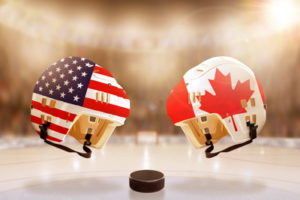 In the 19th century British soldiers and immigrants travelled to the United States and Canada and took their equipment from the various games that they played with them. Given the weather, particularly in Canada, it was inevitable that they would play their favoured games on the ice to stave off boredom.
In the 19th century British soldiers and immigrants travelled to the United States and Canada and took their equipment from the various games that they played with them. Given the weather, particularly in Canada, it was inevitable that they would play their favoured games on the ice to stave off boredom.
According to the Canadian author Roch Carrier, English soldiers would play bandy, whilst those from Scotland would amuse themselves with golf and shinty and the Irish would play hurling. Lacrosse was a popular sport in Canada by then, so the various nationalities would end up attempting to play each other’s game.
Because the games were being played on ice it soon led to the players wearing ice skates to make it easier for them to move around in a more stable fashion. It was, Carrier believes, this swirling mass of sports and the desire of each nationality to learn from each other that began to form the basis of the sport that would become ice hockey.
The Arctic explorer John Franklin wrote in 1825 when on one of his expeditions that ’the game of hockey played on the ice was the morning sport’, suggesting that the sport was already well developed by that stage. There was also a watercolour painting of British soldiers playing hockey on ice done in the mid-1830s.
The Game Begins To Take Form
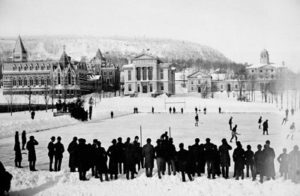 In the decades that followed numerous references were made in writings by various people to ‘hockey on ice’, such as a British army officer based in Ontario writing in 1843 that his skating ability had improved and that he had ‘great fun at hockey on the ice’ as a result.
In the decades that followed numerous references were made in writings by various people to ‘hockey on ice’, such as a British army officer based in Ontario writing in 1843 that his skating ability had improved and that he had ‘great fun at hockey on the ice’ as a result.
At around the same time a First Nations people of the Canadian Maritimes called the Mi’kmaq were playing a stick-and-ball game of their own on ice. The exact origins of the game we know nowadays as ice hockey is unclear, but what is undeniable is that countless people in Canada and the colder states of the US were playing games on the ice that involved the use of a stick and a ball.
The first game of a sport closer in nature to the ice hockey that is played today took place at Victoria Skating Rink in Montreal on the 3rd of March in 1875. It involved 2 teams with 9 players on each playing a game that used a piece of wood that was flat and circular in nature as the ball. The posts that were used as goals were 8 foot part compared to the 6 foot of today’s posts, but there were striking similarities in play.
By the following year games played in Montreal were done under the Hockey Association rules for England’s field hockey matches, showing that the sport hadn’t quite shifted from its English origins but also that there was a desire for it to forge its own path.
Clubs Are Formed & The Rules Develop
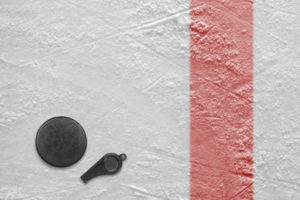 In 1877 McGill University Hockey Club became the world’s first ice hockey club, being quickly followed by Quebec Hockey Club the following year and the Montreal Victorias 3 years after that.
In 1877 McGill University Hockey Club became the world’s first ice hockey club, being quickly followed by Quebec Hockey Club the following year and the Montreal Victorias 3 years after that.
With each passing year more and more clubs were formed, leading to the 1883 creation of the World Championship, which took place during the Winter Carnival in Montreal. It saw matches of two 30 minute halves and also involved the naming of the various positions of players on the ice, made easier by the reduction in team size from 9 to 7.
The sport continued to develop and grow to the extent that there were nearly 100 teams in Montreal alone by 1893, with other teams being formed elsewhere in Canada.
The rules continued to develop and change, but it would take until the formation of the National Hockey Association in 1910 before they would be refined to become something more akin to what hockey fans today would recognise. That was when the game shifted to be 3 20-minute periods, for example. Interestingly, even today the exact rules being used by the participants depends on the code of play that they are part of.
Rules and How Ice Hockey Is Played
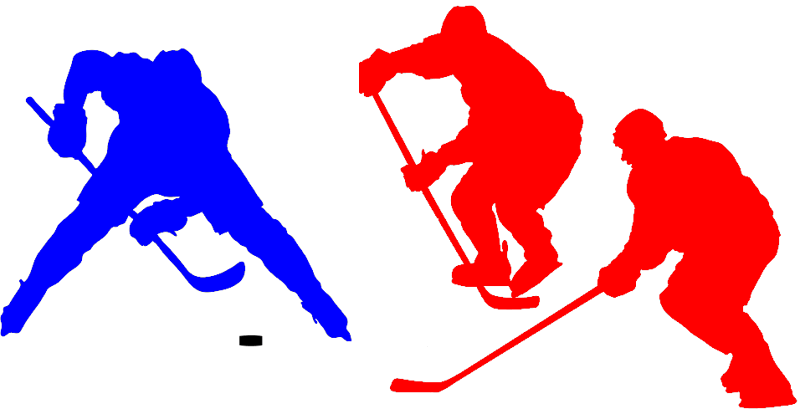
Regardless of the code of play in effect, certainly things remains the same. It is a game played in a hockey rink and each team has 6 players, 1 of whom is the goaltender.
Everyone wears ice skates and the aim of the game is to score more goals than the opposition team, with goals being scored by striking a vulcanised rubber disc, which is known as a puck, into the other team’s goal net.
It is worth noting that even the size of the rink and its layout differs between IIHF rules and those of the NHL. The difference between the two organisations is that the NHL is responsible for organising games in in the North American professional leagues whilst the IIHF does so in the rest of the world.
For the purpose of this piece we’ll mainly be looking at the NHL’s rules, but the differences are subtle enough to mean you’ll get the general idea either way.
The rules have changed even in relatively recent times, with 1930s ice hockey matches forbidding the forward pass of the puck and played in a similar manner to rugby. That way of playing required exceptional individual skill to be able to drive the puck up the pitch, but the move to a game that allowed players to pass the ball forward meant that it became more of a team sport.
Players can use physical bodily force to dispossess their opponent of the puck, which is where the idea that ice hockey is a violent sport comes from. The main ways that they can’t do that is by body-checking above the shoulder or in the back. If a player commits a minor infraction of the rules then they’ll get a 2 minute timeout, though they can come back on if a goal is scored by the opposition during that time. Major penalties see players leave the rink for 5 minutes.
The Teams
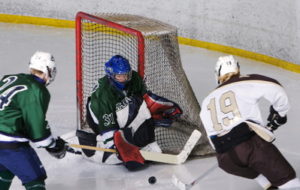 Typically speaking, each ice hockey team boasts a goaltender, 2 defensemen and 3 forwards. The forward positions are broken down further into 1 centre and 2 wingers, with the wingers usually playing on either the left or the right.
Typically speaking, each ice hockey team boasts a goaltender, 2 defensemen and 3 forwards. The forward positions are broken down further into 1 centre and 2 wingers, with the wingers usually playing on either the left or the right.
When it comes to the defensemen, they also typically favour either the left or the right. It’s common for players to play together regularly and when substitutions happen they often involve the changing of the entire unit, which is known as a line change.
Given that teams can have up to 20 players, it’s clear that these changes happen with a degree of regularity. Indeed, teams can make as many substitutions during a match as they’d like to, with players that have been taken off re-entering the pitch later on.
In International Ice Hockey Federation rules the total number of players is 20 plus 2 goaltenders, whilst the NHL say it should be 18 plus 2 goaltenders.
The Rink
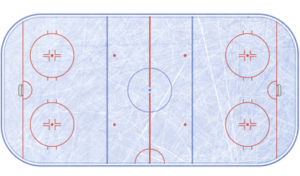 Ice hockey rinks usually measure 61 metres in length by 30 metres in width, though this is slightly altered by the fact that the corners are curved. The goals are located at either end of the rink and are surrounded by a semi-circle known as the crease that is usually blue.
Ice hockey rinks usually measure 61 metres in length by 30 metres in width, though this is slightly altered by the fact that the corners are curved. The goals are located at either end of the rink and are surrounded by a semi-circle known as the crease that is usually blue.
There are lines at various points on the rink that denote certain parts such as the defensive zone, with one in the middle of the rink that has a circle in it and is where games begin. There are also what are known as ‘faceoff’ zones, which is where action resume from by a match official dropping the pitch between 2 players who are facing each other and will attempt to win possession.
In essence, the rink is split into thirds, with the middle section being ‘neutral’ and the others being attacking or defensive zones depending on which team is in possession.
The Equipment
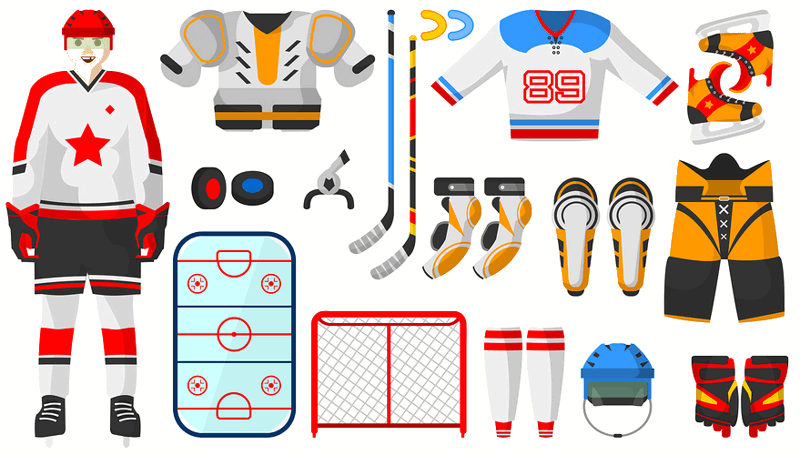
Every player on the rink wears ice skates on their feet as well as helmets for protection. Players also have a hockey stick with which they can hit the puck.
When it comes to what they wear, players tend to have on a face mask, shorts that are padded, guards for the arms, gloves and shoulder pads. Goaltenders tend to have much denser versions of the same things because the puck can be hit at them with a large degree of speed.
Pucks are made of a dense, vulcanised rubber that weighs around 6 ounces. It can only be handled by the goaltenders but it can be kicked with the skates.
Scoring
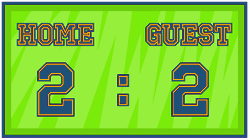 If the puck is hit over the line then a goal will be scored. Players can use any body part except for their hand to get the puck across the line, but the entirety of the puck needs to cross the line in order for a goal to be given. Most professional leagues have sensors to determine whether this has happened.
If the puck is hit over the line then a goal will be scored. Players can use any body part except for their hand to get the puck across the line, but the entirety of the puck needs to cross the line in order for a goal to be given. Most professional leagues have sensors to determine whether this has happened.
If the game is tied by the end of the 3 periods of 20 minutes, with time stoping for infractions and being added on, then overtime comes into play. That involves the playing of an extra quarter up until one of the teams scores, at which point they are declared the winner.
Ice Hockey Major Tournaments
| Competition | Country | Information |
|---|---|---|
| National Hockey League | Canada / America | Created in 1917, the NHL features 24 American teams alongside 7 from Canada. Split into 2 conferences, 8 teams make it to the play-offs for the Stanley Cup |
| National League | Switzerland | Founded as the NDA in 1938, this is a league for 12 teams in Switzerland |
| Kontinental Hockey League | Nordic Europe / China | This is a league for 25 countries from numerous countries in Russia, China and Europe. Created in 2008, the winners get Gagarin Cup |
| American Hockey League | America / Canada | Something of a developmental league for the NHL, it was formed in 1936 and features 31 reams from the US and Canada |
| National Women’s Hockey League | America | Set up in 2015, this was the first women’s league to pay all players as professionals |
| World Ice Hockey Championships | International | This annual event sees around 40 teams play across 3 divisions |
| Olympic Games | International | One of the biggest events in ice hockey away from the NHL, it debuted at the Summer Olympics in 1920 but became a Winter Olympics sport in 1924. Women’s ice hockey became part of the Games in 1998 |
Ice hockey isn’t just limited to Canada, even if that is the country where it is most popular. Above we look at the game’s biggest tournaments and competitions.
Drop into any country where ice hockey is popular and you’ll find tournament that you’ll be able to watch and bet on. That is not a complete list, therefore, but a useful one.
